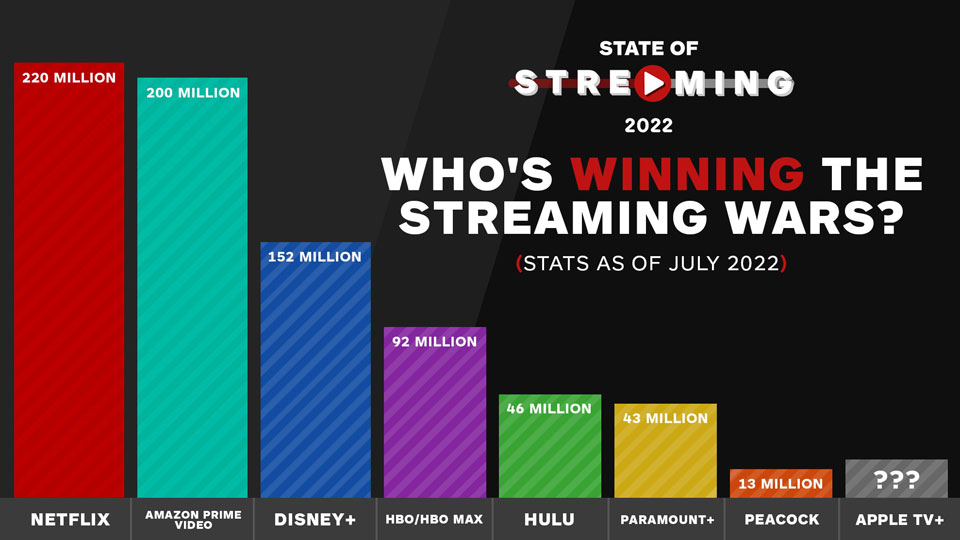
If the buzzword for corporate streaming in 2021, with life still centered online as COVID lingered, was “expansion,” the key phrase in 2022, with nuclear war looming, inflation and rising interest rates deflating salaries, and climate destruction worsening, was “retrenchment.” The turnaround of what was once part of one of the last of the still thriving sectors of capitalist enterprise was so fast and so wide ranging that in March Netflix’s rising subscription rates were still the toast of Wall Street, but by April a one-quarter decline brought on a 35% loss of valuation as the company shed $50 billion in one day.
The tech industry as a whole—and the entertainment industry is now a branch of that sector after the mass movement to online streaming during COVID—suffered huge losses with the most stark of these being the crypto company FTX which went in days from a valuation of $32 billion to bankruptcy and which was described in court documents by creditors trying to reclaim their money as “a Ponzi scheme” with $8 billion “accidentally” missing from the books. The 30-year-old owner, who at one point talked about buying Goldman Sachs, also contributed $1.5 million to the U.S. war in Ukraine as well as bankrolling, to the tune of $70 million, both Democratic and Republican candidates in the November election, and in that way spreading the fictitious wealth around.
The Big Three streaming companies, Disney+, Netflix and HBO, have all sustained losses in both subscribers and market valuation over the last year, to the point where Wall Street has now made a shift and no longer values simple gain in subscribers but instead is looking at the actual worth of these companies, that is, are they actually profitable? The answer to that is, of course, no. They are hugely in debt and none of the streamers have as yet turned a profit. That is, they are part of the debt-driven inflated U.S. economy as a whole which is entirely dependent on the promise of the future and the willingness of investors to believe in that promise. All of which the social philosopher and political economist Karl Marx termed “fictitious capital,” noting that these enterprises created no real worth or value for society.
That is not entirely the case here since each is in the entertainment business which does create potentially socially useful products, in this case, serial series. The problem is the “use value” of these products, that is, their potential to improve the lives of those who consume them is always tempered, mitigated and often corrupted by their “exchange value,” that is, how many people they reach and new subscribers they appeal to, and how that boosts the market value of the company.

At the beginning of the streaming era, in the 2000s, a high price was put on “quality TV,” as “showrunners” carved out a place for more sophisticated, intelligent or “Complex TV” which replaced the morass of cheap to make “Reality TV.” But as the bigger players entered the arena, they have brought with them an increased emphasis on the profit motive of the streaming company which has resulted in a reversion to past media formulas. Thus, we have new kinds of homogenization, where many of the shows, which viewers often find “unwatchable,” are simply designed to appeal to a faceless “middle class” where crass consumerist values dominate. Just as in the television network era of old, but which is also still with us, when one series or genre happens to resound with some sector of the public, the streamers then rush to follow that trend and create their own version.
With the success of Netflix’s Emily in Paris, a high-end fantasy view through the eyes of a young female American associated with the fashion industry of a Paris that looks nothing like that of the city today but which appeals to viewer’s dreams of the city, the second season of HBO Max’s The Flight Attendant, seeking the same demographic, became even less a narrative than season one, and instead was a globe-hopping travelogue of its female heroine in fashion hotspots in the U.S. and Europe.
This is especially true of the fantasy genre, where each streamer has allocated more and more money to have its own in-house mega production following the success of HBO’s Game of Thrones. HBO has its sequel/prequel Throne of the Dragon, Disney+ has its Star Wars franchise and the George Lucas fantasy version of that myth Willow, Netflix its medieval Witcher and super-powered Sandman produced by Warner Television, and Amazon its Lord of the Rings prequel and origin story The Rings of Power. As the mutations proliferate, the originality of each series declines.
The streaming backlash began in April after Netflix subscribers declined (by 200,000) for the first time in its 2022 first quarter report. The company lost 25% of its worth. In reaction, as is happening in all quarters of the tech industry, the company laid off 300 workers and eventually 3% of its work force. In addition, the streamer instituted advertising into a model where the company had boasted it would never do that, and began canceling series it would usually renew, such as Glow and She’s Gotta Have It.

Mouse in the house
The Disney+ shakeup, after the company reported $1.5 billion in losses from streaming in November, involved replacing the Disney head Bob Chapek with its former head Bob Iger and a supposed return to a more “creative friendly” environment. Chapek had attempted to install a more vicious cost-cutting regime throughout the magic kingdom where even its once profitable theme park customers were complaining of nickel and diming.
Probably the grandest fiasco, though, was Warner Bros where AT&T, once it had bought the company, installed its own head, John Stankey, as boss of the entertainment complex. Stankey was a “no-nonsense” leader who proposed to take the company global by producing quantity not quality, with a tilt toward more inexpensive game shows and reality TV. He simply wanted more hours of entertainment which meant that HBO Max would dilute the HBO programming. The response of the HBO head Richard Pepler, who then left the company, was “more is not better, better is better.”
AT&T botched the job so badly with its bottom-line uninspired programming that it had to spin Warners off and eventually merge it with the Discovery Channel, though the conservative Texas company still controls 71% of the stock. The Discovery Channel leader David Zaslav was appointed head of the enterprise not because he would add quality to the HBO Max stable but because, under his “frugal” boss the media baron John Malone, he too learned how to trim a budget, and that is what he has done. He immediately canceled the CNN streaming platform CNN+, the $90 million nearly finished film Batgirl, and did not renew the HBO series Westworld. He also tried to cancel the Warner Bros. Screenwriting Program which selects and trains new writers, that is, the entertainment complex’s future, but the outcry was so great he had to rescind that decision.

These actions, of course, have consequences beyond the insular world of streaming. Warners is being sued for exaggerating its subscribers by, among others, Ohio pension funds, a stable of many teachers, who claim the funds have lost $25 million on the company’s inept shenanigans.
Climate and other catastrophes
What is responsible for these losses? There are several factors limiting subscriptions, but three figure prominently in the global macro picture since the streaming pool in the U.S. is saturated and the companies need foreign expansion to show profit. The same factors also limit expansion in the U.S. where at present an average household has an unsustainable four streaming subscriptions a month, plus cable.
The first factor is global warming. Summer 2022 was the hottest on record for Europe and China, approximately 25% of the global population. In addition, because of global warming, ordinary weather catastrophes—droughts, fires, floods, tornadoes, earthquakes, tsunamis and volcanos—have increased in magnitude. Needless to say, in the aftermath of these dire global disruptions, streaming TV is not the first thing on local consumers’ minds. Anticipation of more dire weather changes to come has also prompted the programming response of Apocalyptic TV series, many of which are not about trying to avert the disaster but coping with and accommodating to its inevitability.

The second major trend impinging on global audiences is the threat of global war, the disaster not only of the proxy war against Russia in Ukraine but also the anticipation of new global conflicts as the U.S. and NATO up the ante in now also pursuing possible simultaneous wars with China, North Korea and Iran—all of which make more likely the possibility of nuclear war, since most of those countries have nuclear arsenals which they are potentially willing to let loose if the U.S. continues its drive for “regime change” in its quest to return to a unipolar world in which it dominates. With the various embargoes on these countries, and especially that on Russia, European and global consumers who now must choose between food, shelter and energy or electricity have less left over for streaming TV.
Another result of these current and prospective wars is the way the closing down of these potentially lucrative markets inhibits profits, such that one factor in triggering the Netflix crisis which started this collapse was losing 700,000 subscribers in Russia. This points to an overall emphasis, as in the collapse of the Weimar Republic in Germany, on the heavy industries of weapons manufacture and energy, that is, oil and fracking, with a corresponding deemphasis on light industry—communications in this instance—which thrives in open rather than closed borders. In the Germany of the late 1920s the dominance of heavy industry led to fascism.
Third, the inflation crisis is just the most recent in a series of global economic shocks, that began with the collapse of the housing market bubble in the U.S. in 2007-8, which eventually spilled over into the European state debt crisis of 2009-12. COVID then exacerbated what was already one of the capitalist economy’s periodic recessions, which was then followed by the current inflation crisis as greedy owners coming out of the lockdown raised prices far beyond those that would cover their losses. Wages, however, stagnated, making consumers, having suffered through the effects of these sequential shocks, less likely to consider streaming TV a must. The way the U.S. tackled the problem, raising interest rates, which was then picked up by other Central Banks, increased the pain of those middle- and working-class audiences in the U.S. and beyond who then found borrowing more difficult for the ever- accelerating costs of college, health care and maintaining a suitable standard of living.
A final factor is that as the streamers cut costs, and as they homogenize product in a competition where each is afraid to distinguish themselves too much from each other, the initial creativity unleashed at the outset of streaming serial TV suffers, and people lose interest because the series do not speak to their lives but rather accelerate in a frenzy of, as suggested by the French term for “entertainment,” divertissement, or diversion. That is, to put it simply, the series are not as good as they used to be.
All is not lost. Part 2 of this series will discuss those serial series which, rather than ignore, responded in various ways, some of them oblique and metaphorical, to how these crises affected their audiences. The future of corporate streaming, though, is most likely one of further retrenchment with, for example, the Comcast/Universal/NBC streamer Peacock and the CBS/Paramount company Paramount+ in danger of drowning as audiences tire of an endless array of ever cheaper series whose “bread and circuses” are what is offered to them as all around them Rome burns.
I’ll be back next with my Top 30 Series for 2022.









